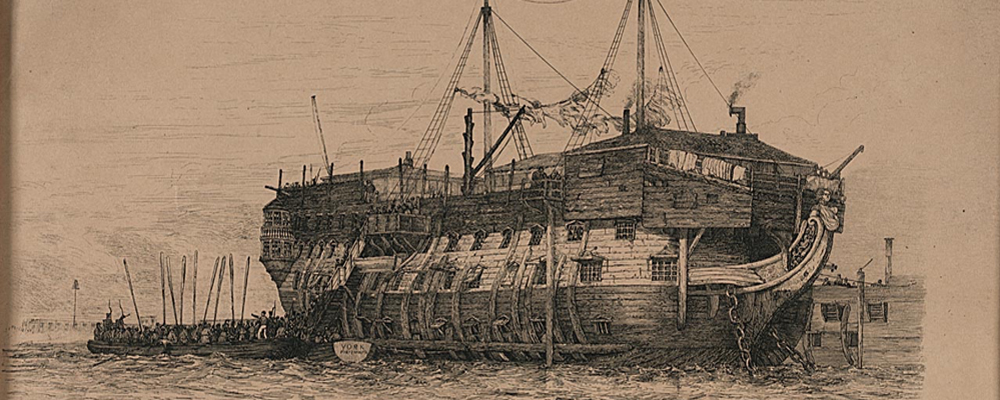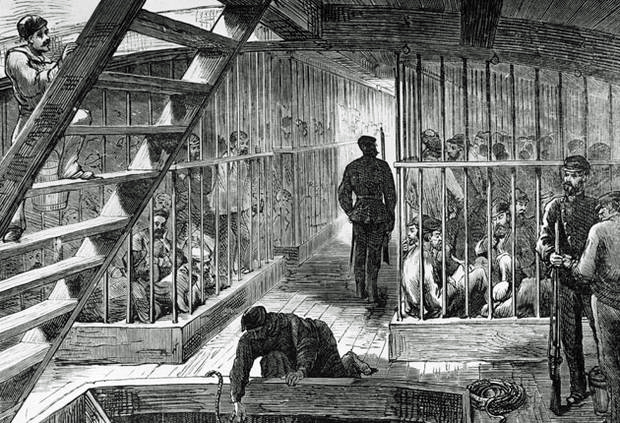 The prison ship, HMS York,
taking prisoners on board in Portsmouth Harbour in the 1830s.
The prison ship, HMS York,
taking prisoners on board in Portsmouth Harbour in the 1830s.
This block will be replaced by LeftMenuGaffey (orByrnes) when the page is served from a server.
Line of Descent to Joan Gaffey
Thomas Berryman
(Great Great grandfather)
- Baptism:
- 21 September, 1794, Gosport, Hampshire, England
- Parents:
- James and Elizabeth Perryman (sic)
- Occupation:
- Labourer
- Lived :
- Portsmouth, Hampshire
- Convicted::
- 12 January, 1835 of larceny in a dwelling house, greater than £5
- Death:
- 28 April, 1835, on board prison hulk
- Marriage:
- Esther Andrews (16 May, 1818, Alverstoke, Hampshire)
- Children:
- Thomas Berryman (1819-1872), married Catherine Stewart, 1844 Hawkesbury River, NSW
- John BERRYMAN (1822-1823)
- William BERRYMAN (1823-1824)
In common with many of our ancestors, life for Thomas Berryman would not have been easy. In Portsmouth, the naval city on England's southern coast in the 1820s, Thomas lost his wife and two infant children within three years.
He'd been born in the previous century, at Gosport, on the western side of Portsmouth Harbour. In 1818, 24-year-old Thomas married 16 year old Esther Andrews who lived in the nearby village of Alverstoke. The young couple moved over to the eastern side of the harbour, near the big naval installation there. They lived in lodgings around the naval base, having their first child, Thomas Jnr, a year later when they were living in Wiltshire Street, Portsea, an inner area of Postsmouth. Two more sons followed, John and William, but both died when each was less than 12 months old.
For Thomas Snr, his tragedies didn't end there. Six months after young William's death, Esther herself died, leaving 37 year old Thomas to care for his remaining child, six-year-old Thomas Jnr. The various causes of death of his family members aren't known - their deaths preceded the official English registration/certification of births, deaths and marriages, which came into effect 12 years later, so all we have are the burial notices in the registers of the local parish church.
The next 10 years of Thomas' life are a closed book. (There is a record of another Thomas Berryman in the early 1830s who was sentenced to death, and then pardoned, in a case involving the destruction of agricultural machinery in rural Hampshire. However, it's unlikely this is our Thomas, since the agricultural protests were happening quite some distance from Portsmouth, and this Berryman was pardoned after a petition from neighbours who said he was a loving husband and father. By that time, Thomas' wife had been dead more than six years).
His next confirmed record is when he came to the official attention of a court in Portsmouth in January, 1835. Thomas was arrested and, along with his 16 year old son, charged with "larceny of a dwelling house", involving a sum greater than £5. For that crime, father and son were sentenced to be transported for life to New South Wales.

From there, life - or what was left of it - was all
downhill.
While awaiting transportation, he and young Thomas were incarcerated on some of the infamous prison hulks anchored in Portsmouth Harbour.
These hulks were dilapidated former naval ships, well past their use-by dates as warships, converted into grossly overcrowded jails for hundreds of criminals. Conditions, to say the least (right), were primitive, and within three months, Thomas' health was recorded as failing, and on 28 April, 1835, he died, aged less than 50 years. The teenage Thomas was left alone to mourn his father, and be taken to a new land, and a new life.
Note: Thomas is probably buried in an unmarked grave on Burrow Island
(also known as Rat Island) in Portsmouth Harbour. According to
Wikipedia, "Burrow Island was once used as a burial ground for
convicts; several human skeletons were discovered on the island early
in 2014. They are believed to be from the 19th century and are the
remains of convicts or prisoners of war who had been buried on the
island". For more information on this island and its
archeological ruins, click
here.